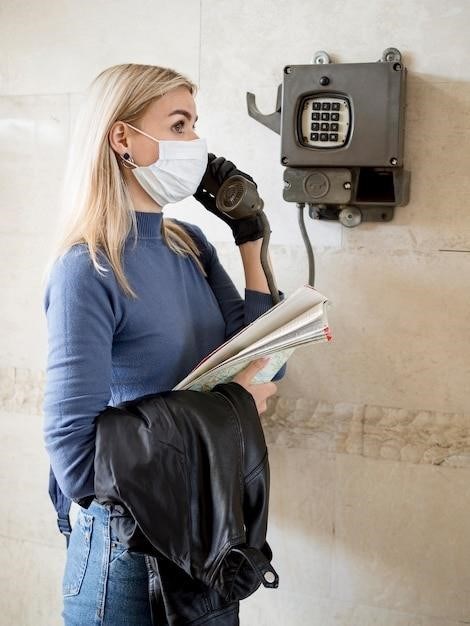
MSA Altair 4X Manual⁚ A Comprehensive Guide
This manual provides a complete guide to the MSA Altair 4X multigas detector. It covers safety, operation, calibration, troubleshooting, sensor details, data management using MSA Link software, technical specifications, and compliance certifications. Download the PDF for detailed instructions and maintenance procedures.
Safety Regulations and Correct Usage

Before operating the MSA Altair 4X, ensure you have received adequate training and understand the safety precautions outlined in this manual. Only trained and qualified personnel should use this device. The Altair 4X is intended for hazard assessment, measuring combustible and toxic gases, and oxygen levels. Never use the device in an atmosphere that is immediately dangerous to life or health (IDLH) without appropriate respiratory protection. Always follow local safety regulations and company protocols. Regularly inspect the device for any signs of damage before each use. Replace sensors according to the manufacturer’s recommendations to maintain accuracy and reliability. Ensure proper calibration is performed at specified intervals (consult the calibration section for details). The device’s alarm system should be tested routinely to confirm functionality. Immediately replace the device if it malfunctions or shows signs of damage. Understand the limitations of the device and do not rely solely on it for complete safety. Always use appropriate personal protective equipment (PPE) and follow all safety procedures specific to your work environment. Improper use can lead to serious injury or death. Consult the full manual for complete safety guidelines and operational procedures.
Operational Procedures⁚ Calibration and Data Logging
Calibrating your MSA Altair 4X ensures accurate readings. The manual details both manual and automatic calibration procedures using the Galaxy Test Stand (refer to Appendix for detailed steps). Regular calibration, at least every six months or as per local regulations, is crucial. Before calibration, inspect the sensor for damage and ensure it’s clean. Use calibration gases of known concentrations. Follow the on-screen prompts during the calibration process. After calibration, verify the readings against known standards. The device automatically logs data, recording readings, date, time, and sensor information. Access this data via the device’s interface or using MSA Link software. MSA Link provides comprehensive data management capabilities. The software allows for easy download, analysis, and report generation. Data logging intervals can be customized to meet specific requirements. Refer to the MSA Link documentation for comprehensive instructions on software setup and data interpretation. Proper data logging practices are essential for compliance and for tracking environmental conditions over time. Ensure that the device’s memory is sufficient to store the required data. Regularly review and archive data according to your company’s data retention policies.
Troubleshooting Common Issues and Maintenance
This section addresses common MSA Altair 4X problems and maintenance procedures. If the device displays an error message, consult the troubleshooting section in the manual for specific solutions. Common issues include sensor errors, battery problems, and communication failures with MSA Link. Sensor errors often indicate the need for calibration or sensor replacement. Battery issues may require charging or battery replacement. Communication problems with MSA Link may necessitate checking the device’s Bluetooth connection and software compatibility. Regular maintenance is crucial for optimal performance and longevity. This includes inspecting the device for physical damage, cleaning the sensor, and ensuring proper storage. Avoid exposing the device to extreme temperatures or harsh environments. Clean the casing with a soft, damp cloth. Never use abrasive cleaners or solvents. Always follow the manufacturer’s instructions for sensor replacement and battery maintenance. The manual provides step-by-step guidance for these procedures. Proper maintenance prevents premature wear and tear and minimizes downtime. Keep records of maintenance performed, including dates and actions taken. This information is crucial for regulatory compliance and efficient troubleshooting. Contact MSA support for assistance with complex issues or if maintenance is beyond your capabilities. Proactive maintenance ensures the continuous reliable operation of your MSA Altair 4X.
Understanding Sensor Types and Life Expectancy
The MSA Altair 4X utilizes various sensor types depending on the specific gas being monitored. Understanding these sensors and their life expectancy is crucial for maintaining accurate readings and ensuring workplace safety. Common sensor types include electrochemical sensors for toxic gases like carbon monoxide (CO) and hydrogen sulfide (H₂S), and catalytic sensors for combustible gases such as methane (CH₄). Each sensor type has a unique lifespan, typically measured in years of operation or exposure to specific gas concentrations; These lifespans vary depending on the type of gas, operating conditions, and frequency of use. The manual provides detailed information on the expected life of each sensor type within the Altair 4X. Factors like high gas concentrations, extreme temperatures, and humidity can significantly reduce sensor lifespan. Regular calibration helps to extend sensor life and maintain accuracy. However, even with regular calibration, sensors will eventually need to be replaced. The manual outlines recommended replacement schedules. Always use MSA-approved replacement sensors to ensure accuracy and compatibility. Replacing sensors is a critical maintenance procedure, and the manual provides detailed instructions for this process. Failure to replace sensors as recommended can lead to inaccurate readings, potentially compromising workplace safety. Note that sensor life expectancy is an estimate, and actual lifespan can vary based on usage and environmental conditions. Monitoring sensor performance and proactively replacing them according to the manufacturer’s guidelines are crucial for maintaining the effectiveness of the MSA Altair 4X;
Utilizing MSA Link Software for Data Management
The MSA Link software provides a comprehensive solution for managing data collected by the Altair 4X multigas detector. This software facilitates efficient data logging, analysis, and reporting, streamlining the process of monitoring gas levels in various work environments. MSA Link enables seamless communication between the Altair 4X and a computer, allowing for easy download of recorded gas readings, calibration data, and other crucial instrument information. The software offers a user-friendly interface for reviewing and analyzing this data, providing valuable insights into potential hazards and ensuring compliance with safety regulations. Users can generate detailed reports, customize data displays, and set up alerts based on pre-defined thresholds. This allows for proactive identification of potential safety issues and enables timely interventions to prevent accidents. MSA Link also simplifies the management of multiple Altair 4X devices. Users can easily monitor and manage data from various instruments simultaneously, providing a centralized overview of gas levels across different locations or work areas. The software’s reporting capabilities are invaluable for compliance documentation and audits. The software automatically generates reports that adhere to industry standards, simplifying the process of demonstrating compliance with safety regulations. Regular updates to the MSA Link software ensure compatibility with the latest Altair 4X firmware and introduce new features and improvements to enhance data management capabilities. The manual includes a section dedicated to installing, configuring, and operating MSA Link software, providing users with step-by-step instructions and troubleshooting tips. Efficient data management is crucial for ensuring workplace safety and complying with regulations, and the MSA Link software is a valuable tool for achieving both.
Technical Specifications and Compliance Certifications
The MSA Altair 4X boasts a range of technical specifications designed for optimal performance and reliability in diverse environments. Key specifications include sensor types and their respective ranges, accuracy levels, response times, and operating temperature limits. Understanding these specifications is crucial for appropriate instrument selection and deployment in specific applications. The device’s dimensions, weight, and power requirements are also detailed, enabling users to assess its suitability for different working conditions and operational needs. Furthermore, the manual outlines the battery life and charging procedures, ensuring optimal device uptime and operational efficiency. The Altair 4X adheres to stringent international safety and quality standards, evidenced by its compliance certifications. These certifications are vital for ensuring the instrument meets rigorous performance and safety requirements. The manual explicitly lists these certifications, providing users with assurance of the device’s reliability and suitability for use in various regulatory environments. Detailed information on the certifications confirms compliance with relevant directives, standards, and regulations, such as ATEX and other industry-specific standards, ensuring users operate the device in full compliance with applicable rules and regulations. This section also includes information on the instrument’s warranty, outlining the terms and conditions for repair or replacement in case of defects or malfunctions. This comprehensive approach to technical specifications and compliance certifications ensures transparency and assists users in understanding the capabilities and limitations of the Altair 4X within its intended operational parameters and regulatory contexts. By providing this crucial information, users can confidently select and deploy the instrument for their specific monitoring needs, ensuring compliance and workplace safety.
Appendix⁚ Detailed Calibration Procedures
This appendix provides comprehensive step-by-step instructions for calibrating your MSA Altair 4X multigas detector. Accurate calibration is essential for ensuring the instrument’s readings are reliable and safe. The procedures detailed here cover both manual and automated calibration methods, using the MSA Galaxy Test Stand where applicable. Before beginning any calibration, ensure you have the necessary calibration gases, appropriate safety equipment, and a clear understanding of the safety precautions outlined in the main manual. The appendix details the specific calibration gases required for each sensor type included in your Altair 4X configuration. Precise concentrations and flow rates are specified to guarantee accurate calibration results. Each step in the calibration process is explained clearly and concisely, with accompanying diagrams or illustrations where necessary. This ensures users, regardless of their experience level, can perform the calibration accurately and efficiently. Troubleshooting common issues encountered during calibration is also addressed, providing solutions for resolving any problems that may arise. Special attention is given to the proper handling and storage of calibration gases, ensuring user safety and the integrity of the calibration process. Furthermore, the appendix includes a record-keeping section, encouraging users to maintain a detailed log of all calibration events. This log should include dates, times, calibration gas used, and the resulting calibration data. This detailed approach ensures compliance with regulatory requirements and provides a valuable history of instrument performance. By following these detailed procedures, users can ensure their Altair 4X remains accurately calibrated, providing reliable and trustworthy gas detection data for a safe working environment. Remember to always refer to the main manual for general safety precautions and operational guidelines.

Contacting MSA for Support and Resources
For comprehensive support and access to valuable resources regarding your MSA Altair 4X multigas detector, MSA offers multiple avenues of contact. In North America, you can reach your nearest stocking location toll-free at 1-800-MSA-2222. For international inquiries, contact MSA International directly at 1-724-776-8626 or 1-800-MSA-7777. These numbers provide access to knowledgeable representatives who can assist with technical questions, troubleshooting, parts ordering, and warranty claims. Beyond phone support, MSA maintains a comprehensive website, msasafety.com, which serves as a central hub for product information, manuals, software downloads, and frequently asked questions. The website offers detailed instructions, troubleshooting guides, and videos that can aid in resolving common issues. For specific documentation relating to the Altair 4X, including the operational manual and the latest software updates, refer to the designated product pages on the MSA website. This centralized resource ensures you have the most up-to-date information available at your fingertips. MSA also offers various training programs and workshops designed to enhance your understanding and proficiency with the Altair 4X. These educational opportunities provide hands-on experience and in-depth knowledge of instrument operation and maintenance, ensuring optimal performance and user safety. Should you require on-site support or specialized assistance, contact MSA to explore the possibilities of scheduled maintenance visits or technical consultations. MSA’s commitment to customer support ensures you have the resources necessary to maximize the lifespan and effectiveness of your Altair 4X multigas detector, promoting a safe and productive work environment.